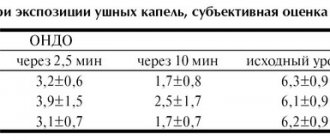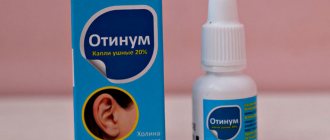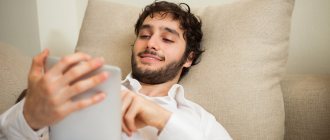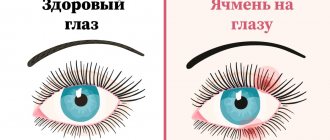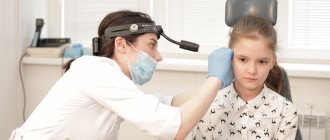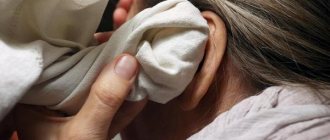There are many diseases that directly affect the hearing organs. However, otitis media is considered the most common. When this disease is detected, the otolaryngologist prescribes various drugs and medications, among which there will certainly be special drops. They are buried directly into the auricle and have a beneficial effect on the source of inflammation. Anti-otitis drops are a serious medicine that should not be taken lightly. If the drug is chosen incorrectly, as well as due to non-compliance with the dosage, the treatment may not only be ineffective, but even dangerous for the hearing organs.
First of all, you need to consult a doctor so that he can determine the degree of the inflammatory process. Depending on the affected area, there are three types of this disease:
- Outdoor . The disease can occur as a result of the formation of boils, injury, or neglect of personal hygiene rules.
- Average . The cause of otitis media in the middle ear may be an infection in the eustachian tube, acute respiratory viral infection, or low immunity.
- Internal . This disease is characterized by decreased hearing and dizziness. It is not separate, but acts as a complication of otitis media.
How to treat otitis in adults and children.
July 2, 2021
9026
5
3
Content
- Why does ear pain occur?
- Causes of otitis media
- How can you get infected with otitis media?
- Symptoms of otitis media
- What types of otitis are there?
- How to treat otitis
- The most popular ear drops for adults
- Sofradex
- Otinum
- Normax
- Otirelax
- Tsipromed
- The most popular ear drops for children
- Otipax
- Polydexa
- Garazon
- Otofa
- Anauran
As soon as our ear starts to hurt, we think about ear drops. And it’s good if they are in your home medicine cabinet. But you need to understand that all ear drops have different therapeutic properties. Some help cope with ear congestion, others relieve severe pain. Therefore, it is very important not to self-medicate, but to immediately visit an ENT doctor if discomfort occurs to determine the cause of ear pain.
Why does ear pain occur?
There are different types of ear pain, so you need to learn to determine which conditions require urgent help and which ones you can handle on your own. You can treat your ear yourself, for example, if you have slight discomfort after a long walk or you took a swim in a pond (perhaps water got into your ear). If the symptoms do not go away or even worsen, do not delay visiting a doctor. The ear can also hurt when a lot of wax is released (or, conversely, not enough). But most often the ear hurts due to otitis, sinusitis, caries, sore throat or eczema. Ear pain can also be caused by injury.
Otitis
is a serious inflammation of the ear tissues, which causes acute pain and decreased hearing. Otitis often affects children under three years of age due to the anatomical features of the ear structure.
Otitis
Do people's ears often hurt?
Inflammation of the middle ear - acute otitis media (AOM) - occurs in up to 62% of children already in the first year of life!!! During the first five years of life in the United States and Western Europe, more than 90% of children experience at least one NDE, which means we need to know how to help ourselves and our children with the development of such a frequent and unpleasant disease.
What is the reason?
No doctor will tell you with certainty what is the cause of otitis media. It is believed that this is more often an infectious disease that can be caused by a virus, bacteria or fungus. This can also be a manifestation of an allergic reaction and occur for other reasons. Otitis is a frequent companion to acute respiratory infections, especially with a severe runny nose. Snot, flowing down the back wall of the pharynx, carries the infection into the auditory tubes, and through them it enters the middle ear. This is how inflammation occurs.
Has your ear blown?
It is a common belief that your ear can hurt if you blow into it! Can't inflate in the ear. Otitis is not a contagious disease and does not occur from wind and cold. It cannot be prevented by regularly wearing a hat or wrapping the ear. The middle ear is completely isolated from the external environment by the eardrum, which does not allow air or bacteria to pass through. The infection enters the middle ear from the nasopharynx, since the middle ear is connected to the nasal cavity by a hollow cartilaginous tube - the Eustachian tube.
Different otitis media: AOM or ESO?
Normally, the Eustachian tube opens when swallowing, and through it mucus from the inner ear flows into the nasopharynx (have you heard the clicking sound in your ears when swallowing? - the tube opens!). When there is inflammation in the nose, the mucous membrane of this tube swells and blocks the exit of mucus from the middle ear, the ear is bursting with accumulated mucus and sharp pain is observed, there is dizziness, vomiting, high (up to 40) temperature and even decreased hearing. But this is not yet acute otitis media, it is called acute exudative otitis (ESO), sometimes this otitis is called tubootitis or eustacheitis. It lasts on average 48 hours. It may go away on its own, or if the accumulated mucus becomes infected, it may be complicated by acute otitis media.
Are we eating antibiotics?
Otitis media is one of the leading reasons for the prescription of antibiotics, often unjustified. In France, more than 3 million and in the United States about 30 million prescriptions for antibiotics are written annually for acute otitis media.
But is it necessary to take antibiotics if otitis media occurs?
Not always. There are publications showing that antibiotics have no effect at all on recovery from otitis media. And why, one might ask, poison the body? But in a real situation, it is necessary to take into account the likelihood of developing complications of otitis, and these complications are as follows: perforation (that is, a hole) of the eardrum, adhesion (gluing) of the auditory ossicles or their destruction, brain abscess, meningitis. That is why it is impossible to unequivocally refuse antibiotics for otitis media.
But you need to know that:
Antibiotics are indicated only for AOM, but should not be used for EOM (tubo-otitis), that is, in the first 48 hours after the onset of the disease, if a person has a viral disease, i.e. ARVI, then antibiotics are even harmful, they will weaken the immune system and cause allergization. The diagnosis of AOM requires confirmation of the presence of effusion in the middle ear, that is, if, during examination by an ENT doctor, a hyperemic and bulging eardrum is noticed, in combination with acute local manifestations (severe pain) and general symptoms (dizziness, vomiting, temperature), then this is truly acute otitis media and here you need to take antibiotics (not for otitis, but for possible complications!)
We treat ourselves
How can we help ourselves or our child with acute pain in the ear when otitis suddenly begins? Firstly, you need to provide the child with bed rest and rest, especially if he has a fever. It is necessary to lay the child with the sore ear up and drop a few drops of Otipax there (if there was no perforation of the eardrum before!), give the child an anesthetic (Panadol, Efferalgan or Nurofen in syrup for children, in a dose appropriate to the age and body weight of the child ( according to the instructions), drop a few drops of a diluted solution of “dolphin” or aqua-maris into the nose (the previously fashionable vasoconstrictor drops give a temporary and not radical effect, and after them there is often a “recoil” effect - the nose becomes even more stuffy, so these remedies are without It is better not to use urgent doctor's recommendations!) and give the child to chew the child's orbit. Yes, yes, give him chewing gum! Let him chew it 4-6 times a day during the entire illness with otitis media. This will lead to the opening and cleansing of the auditory tubes, possibly and to a quick recovery. Chewing gum is so useful for runny nose and otitis media that there may be talk of an alternative to antibiotics! Xylitol (xylitol), a natural 5-hydroxy alcohol contained in chewing gum, has been shown to inhibit in vitro the growth of bacteria Streptococcus mutans and S. pneumoniae. Using chewing gum (5 times a day) with xylitol reduces the incidence of acute otitis media in children by 1/3! And of course, the child must be shown to an ENT doctor. After all, it is he who can, upon direct examination, determine what kind of otitis media a patient has - exudative or already moderate?! And better, earlier. If a doctor is not available, Otipax drops should be instilled every 15 minutes 3 times, and then every 2-3 hours, and then less often, 3 times a day. These measures often save you from otitis media in 1-2 days than waiting a long time for the doctor to come or for you to get an appointment with him. It is also useful to have a blue glass lamp at home (a regular blue light bulb 60-75 W) and screw it into a table lamp instead of the usual one to warm the child’s sore ear 1-2 times a day from a distance of 15-20 cm for 5 minutes for 7-8 days in a row. . If the measures indicated in this booklet do not help within 48 hours after the onset of acute pain, a doctor should definitely see the child! He will probably still have to take an antibiotic or undergo some kind of medical procedure.
How to avoid getting otitis media?
To avoid getting otitis media at all, you must not get a runny nose! Neither removal of enlarged adenoids (proven by research) nor antibiotic prophylaxis can prevent otitis media. Most often, otitis media occurs from improper nose blowing!
How to blow your nose correctly?
How to blow your nose incorrectly: they pressed a handkerchief over the child’s nose and said, “Blow!” He will blow, but only the entire infection will fly into the ears through the Eustachian tube. How to blow your nose correctly: do not pinch your child’s nostrils! No need to press the wings of your nose! Let him blow his nose once or twice like this (and just keep the handkerchief next to your nose, don’t touch your nose at all, wipe anything that might get a little dirty, gently wipe it off, for irritation under the nose for a long-term runny nose, use baby cream), and then you can blow your nose like this: one nostril was pressed, the child took in air with his mouth and blew his nose into the free nostril, then change the nostril. And if you immediately pinch the nostril or even press the wings of the nose, as many parents like to do when the child blows his nose, then he will probably suffer from otitis media.
An excursion into psychology
The human body, like a finely tuned musical instrument, sensitively reacts with every cell to changes in the psychological atmosphere around it. Children especially experience stressful moments in life with all their being. And there is an opinion that in those families where the child hears what he does not want to hear (swearing and screaming of parents, extremely emotional arguments between relatives, insults and insults, even “jokingly” inflicted on him or his mother, obscene expressions, swearing) Children suffer from ear diseases more often and more severely. Take care of your children, watch your speech and what the child hears. Don’t wrap your child up, toughen him up, develop him physically, teach him to keep his mouth closed, learn to rinse his nose yourself at home, and use antibiotics only as a last resort when it’s really necessary. Do not shift the concern about your future to the doctor, think about the health of your children yourself, and you will succeed!
THERE ARE CONTRAINDICATIONS - YOU MUST CONSULT A DOCTOR
Symptoms of otitis media
The very first symptom of otitis media is tinnitus. The following symptoms then appear:
- pain of varying intensity;
- temperature increase;
- general weakness;
- hearing impairment;
- discharge from the ears.
IMPORTANT!
If you or your child have noise and congestion in the ears, urgently go to an otolaryngologist - he will determine the cause and prescribe adequate treatment.
Read also: Top 7 effective remedies for a runny nose The best nasal drops and sprays that quickly and effectively help cure a runny nose.
Acute otitis media
According to statistics, acute forms of otitis media account for 30% of the total number of ENT diseases. Most often it occurs in preschool children.
Symptoms of acute otitis media
The disease is characterized by an acute onset with the appearance of the following symptoms:
- earache;
- ear congestion or hearing loss;
- increased body temperature;
- anxiety;
- disturbance of appetite, sleep;
- headache and toothache.
Causes of development of acute otitis media
In most cases, the disease can be caused by various pathogenic microorganisms - viruses, microbes, fungi, etc. In exudate obtained from the middle ear, respiratory viruses are found in 30-50% of cases. The most common causes of otitis are parainfluenza viruses , influenza viruses, rhinoviruses, adenoviruses, enteroviruses, respiratory syncytial viruses, etc.
In 50-70% of patients with acute otitis media, bacteria are detected in the exudate from the middle ear (most often Streptococcus pneumoniae, Haemophilus influenzae, Moraxella catarrhalis).
Often the cause of otitis is a mixed (viral-bacterial) infection.
When making a diagnosis, a differential diagnosis is made with myringitis (inflammation of the eardrum) and exudative otitis media.
The occurrence of otitis media is directly related to the condition of the nose and nasopharynx: rhinitis and tonsillitis often provoke inflammation of the middle ear.
Otitis often occurs against the background of decreased immunity and immunodeficiency states.
1 Diagnosis of otitis in MedicCity
2 Diagnosis of otitis in MedicCity
3 Diagnosis of otitis in MedicCity
Routes of infection
The most common route of infection into the middle ear is through the auditory tube during rhinitis and sinusitis.
It is possible that infection can penetrate through the blood during influenza, scarlet fever and other infectious diseases.
In rare cases, the infection enters the middle ear through the ear canal due to injury (rupture) of the eardrum.
Stages of acute otitis
There are 5 stages of the disease:
- stage of acute eustachitis: feeling of congestion, noise in the ear, normal body temperature (if there is an infection, it may increase);
- stage of acute catarrhal inflammation in the middle ear: sharp pain in the ear, low-grade fever, inflammation of the mucous membrane of the middle ear, increasing noise and congestion in the ear;
- pre-perforative stage of acute purulent inflammation in the middle ear: sharp unbearable pain in the ear, which radiates to the eye, teeth, neck, pharynx, increased noise in the ear and decreased hearing, increased body temperature to 38-39 degrees, the blood picture becomes inflammatory in nature;
- post-perforation stage of acute purulent inflammation in the middle ear: pain in the ear becomes weaker, suppuration appears from the ear, noise in the ear and hearing loss do not go away, body temperature becomes normal;
- reparative stage : inflammation is stopped, perforation is closed with a scar.
What types of otitis are there?
There are several types of otitis:
- Eustachite.
Air exchange in the ear cavity is disrupted, and fluid accumulates there. Which becomes a breeding ground for pathogenic microbes. - Otitis media of exudative type.
Fluid accumulates in the ear cavity, which causes unpleasant symptoms in the patient. Typically, such otitis develops against the background of ARVI, which weakens the immune system. - Acute purulent otitis media.
The ear cavity fills with pus. The inner ear is affected, so serious consequences are possible.
Sofradex
These ear drops have a combined effect - they can be used for both ear and eye diseases. Sofradex drops contain two active substances: gramicidin and framycetin. These ear drops are a powerful drug; it specifically targets pathogenic bacteria that cause the disease. "Sofradex" is suitable for the treatment of otitis and ear diseases of an allergic nature. Drops for the ears and eyes reduce pain, swelling and inflammation. Thanks to Sofradex treatment, it is possible to restore the natural microflora of the ear. Contraindications include pregnancy, breastfeeding and childhood.
Sofradex
Chinoin (Sanofi-Sintelabo), Hungary
Bacterial diseases of the anterior segment of the eye.
- blepharitis; - conjunctivitis; — keratitis (without damage to the epithelium); - iridocyclitis; - sclerites, episclerites; - infected eczema of the eyelid skin; - otitis externa. from 208
5.0 1 review
804
- Like
- Write a review
Otinum
These ear drops are relatively inexpensive and have good anti-inflammatory effects. The active ingredient of Otinuma is choline salicylate. Doctors prescribe Otinum for otitis of the external and middle ear, including fungal infections. Ear drops perfectly relieve pain literally a few minutes after use. Contraindications include damage to the eardrum and childhood. And so the drug is well tolerated, extremely rarely causing allergic reactions. For otitis media, after about seven days of using Otinum ear drops, complete recovery occurs.
Otinum
Polfa, Poland
Acute otitis media, myringitis, otitis externa;
before washing the external auditory canal to soften hardened earwax before the procedure for its removal. from 177
5.0 1 review
620
- Like
- Write a review
Types of otitis
Depending on the direction of the pain, it is customary to distinguish 3 types of otitis: external, middle and internal otitis.
Otitis externa most often appears as a result of mechanical damage to the auricle or external auditory canal. The following symptoms are characteristic of external otitis of the ear: aching, dull pain, swelling of the ear, and a slight increase in temperature.
Otitis of the middle ear is an inflammatory disease of the air cavities of the middle ear: the tympanic cavity, the auditory tube and the mastoid process.
Internal otitis is untreated otitis media of the middle ear. With internal otitis, inflammation of the inner ear occurs and the entire vestibular apparatus is damaged.
Normax
"Normax" for otitis - drops of complex action against many microbes. The drug is intended exclusively for adults. "Normax" is indicated for infections not only of the ears, but also of the eyes. Thanks to the antibiotic in the composition, it effectively treats diseases such as conjunctivitis, blepharitis, otitis media, eustachitis, and keratitis. Patients note that Normax ear drops are affordable, well tolerated, and quickly relieve the problem. But many people talk about allergic reactions to this drug (then it is better to choose a weaker remedy for otitis media). Normax relieves pain well and is popular among patients.
Normax
Ipca Laboratories, India
Treatment of acute and chronic infectious and inflammatory diseases caused by microorganisms sensitive to the drug: - conjunctivitis (including gonococcal);
- keratitis; - keratoconjunctivitis; - corneal ulcer; - blepharitis; - blepharoconjunctivitis; - trachoma; - otitis externa; - acute and chronic otitis media; - internal otitis media; - infectious eustachitis. Prevention of eye infections after removal of a foreign body from the cornea or conjunctiva, after damage by chemical or physical means, before and after surgery. Prevention of infectious otitis before and after surgery, with ear injuries, removal of a foreign body from the external auditory canal, accompanied by damage to ear tissue from 125
405
- Like
- Write a review
How is otomycosis treated at the Rassvet clinic?
When otomycosis is detected, the patient undergoes a thorough toilet of the ear canal under a microscope - using cotton swabs, various probes, and partially the discharge is aspirated. We do not rinse the ears during otomycosis, as this can lead to a worsening of the disease.
Performing an ear toilet under a microscope is more effective, less traumatic (especially when removing fungal masses near the eardrum) and less uncomfortable for the patient.
If a thorough and complete toilet of the ear canal is performed on the first day, the patient will not need to visit the clinic frequently. We monitor the patient at 10-14 day intervals, according to current recommendations.
In case of recurrent otomycosis, the patient is sent for further examination and exclusion of systemic causes and immunodeficiency conditions leading to recurrent fungal infections.
Otirelax
The active ingredients of these combined action ear drops are phenazone and lidocaine. Otirelax relieves inflammation and relieves pain. ENT doctors prescribe these ear drops for bacterial and viral infections. The drug is easy to use thanks to a bottle with a dropper. "Otirelax" is prescribed for otitis media externa, as well as inflammation after ear injuries. As for pregnancy and breastfeeding, the decision to prescribe Otirelax is made by the attending physician.
Otirelax
Rompharm, Romania
For local symptomatic treatment and pain relief in adults and children (including newborns) for: otitis externa;
in complex therapy of otitis media with an intact eardrum; barotraumatic otitis. from 174
386
- Like
- Write a review
Complications of IT
- Periauricular cellulitis is manifested by hyperemia, edema, and local hyperthermia of the skin around the auricle. Pain is usually mild and systemic symptoms are usually absent, which helps distinguish cellulitis from malignant otitis externa.
- Malignant otitis externa (necrotizing) is a severe, potentially fatal complication of bacterial Otitis. It is most common in older patients with diabetes or people with weakened immune systems. In this case, the infection spreads to the base of the skull and surrounding soft tissue. There is severe otalgia and discharge from the ear. In the NSP - granulation, edema, erythema, necrosis (death) of the NSP.
Tsipromed
"Tsipromed" is considered the best inexpensive antibiotic drops for otitis media. These are strong ear drops that destroy not only active bacteria, but also “dormant” ones. Tsipromed is prescribed exclusively to adults. These ear drops very rarely cause allergic reactions, so they are often prescribed for many ear and eye diseases. Many patients respond well to Tsipromed drops, because the product treats otitis media well and saves if water gets into the ear.
Tsipromed
Promed Exports, India
A synthetic broad-spectrum antibacterial drug from the group of second-generation fluoroquinolones for the treatment of acute external otitis, otitis media caused by sensitive strains of Pseudomonas aeruginosa or Staphylococcus aureus.
from 98
380
- Like
- Write a review
Treatment of acute external otitis
To reduce pain, including before being examined by a doctor, it is recommended to use systemic painkillers, such as ibuprofen or paracetamol.
If the eardrum is intact, drops containing painkillers (for example, lidocaine) can be used. However, the advantage still remains with systemic anesthesia, and the issue of using drops with anesthetics is still controversial.
- For mild cases of ON, local agents containing acetic acid and/or glucocorticoid are indicated. Treatment is aimed at changing the environment in the NSP to a more acidic one, as well as reducing inflammation.
- For moderate cases, local agents are prescribed that contain an antibiotic or an antibiotic in combination with a glucocorticoid. The antibiotic must have activity against the most common pathogens of ONO - the drugs of choice are ciprofloxacin, neomycin, polymyxin B. If perforation of the eardrum is suspected, the use of drops containing aminoglycosides should be avoided.
- In severe cases, in addition to local therapy, the option of additional systemic antibacterial therapy is considered - most often oral forms of quinolones (ciprofloxacin or ofloxacin).
Drugs for local use remain the treatment of choice for ANO, as they allow creating a high concentration of the drug at the site of inflammation.
There are no randomized studies comparing topical and oral antibiotic therapy. But according to available data, the addition of an oral antibiotic to local antibacterial therapy for uncomplicated ANO does not have a significant effect on the course of the disease and recovery time.
The basis of treatment for otomycosis is NSP toilet and local antifungal therapy - the drugs of choice are clotrimazole and miconazole. Systemic antifungals are indicated for patients with suspected invasive fungal disease.
General recommendations
- During treatment, the ear should be protected from water - while bathing, a cotton swab soaked in petroleum jelly or glycerin should be placed in the ear.
- It is necessary to refrain from water sports for 7-10 days.
- You should limit the wearing of hearing aids and headphones as much as possible until the pain completely subsides and there is no discharge from the ear.
How is acute external otitis treated at the Rassvet Clinic?
For ONO, we give preference to local empirical therapy. An important stage of treatment is the toilet of the NSP, performed by an otorhinolaryngologist. In the clinic, we perform it under a microscope, which makes the procedure less traumatic and more effective. During the procedure, pathological discharge and granulations are removed from the ear canal, which in turn increases the effectiveness of local treatment.
Our otorhinolaryngologists select medications for local treatment based on otoscopy and medical history. Not only the effectiveness of the antibiotic against the most common pathogens is taken into account, but also their side effects and possible drug resistance.
We prescribe systemic antibiotics only when indicated. First, compared with local therapy, systemic antibiotics may increase the likelihood of drug resistance. Secondly, the use of only oral agents without local antibacterial therapy may lead to relapse of the disease, which is likely due to lower concentrations of antimicrobial drugs at the site of inflammation.
Acute external otitis media resolves within 7-14 days. With a longer course or repeated changes of tactics during the treatment period, frequent relapses, we always exclude other diseases, including immunodeficiency states and oncology.
Otipax
These ear drops are one of the best that pediatricians and family doctors recommend for otitis media. The main active ingredients of Otipax are phenazone and lidocaine: they “work” well in tandem, relieving inflammation and pain relief. Otipax, due to its safety, can be prescribed to pregnant and lactating women, as well as to children from birth. Otipax perfectly treats all forms of otitis media and any viral ear infections. Noticeable relief occurs within 2 minutes after using these ear drops, which, by the way, are suitable not only for children, but also for adults.
Otipax
Biocode, France
Combined preparation for topical use in the form of ear drops.
It has an antiseptic (disinfecting), local anesthetic (local anesthetic) and anti-inflammatory effect. from 172
5.0 1 review
977
- Like
- Write a review
Polydexa
These ear drops contain an antibiotic and the hormone dexamethasone, so Polidexa effectively removes inflammation and reduces swelling. In addition to antimicrobial, these ear drops also have an antifungal effect, although weakly expressed. "Polydex" is often prescribed in pediatrics (can be used from 2.5 years). Children's drops for otitis media perfectly relieve inflammation and eliminate its symptoms. "Polydex" is considered one of the best remedies for ear diseases and has virtually no age restrictions.
Polydexa
Laboratories Bouchard-Recordati, France
Polydexa is a drug with antibacterial, anti-inflammatory and vasoconstrictor effects for topical use in ENT practice.
When combining these antibiotics, the spectrum of antibacterial action expands on most gram-positive and gram-negative microorganisms that cause infectious and inflammatory diseases of the nasal cavity and paranasal sinuses. from 188
993
- Like
- Write a review
Garazon
The active ingredients of these ear drops for children are gentamicin and betamethasone. “Garazon” for otitis media acts locally and specifically “hits” the source of infection. These ear drops relieve swelling, improve capillary permeability, and are prescribed for seasonal allergies. "Garazon" for otitis media can be used in children from 8 years of age. By the way, the drug is also suitable for the treatment of eye diseases (even with the presence of pus). Relief occurs literally 20 minutes after using the drug. Many patients highly praise these ear drops because they are effective and at the same time quite affordable.
Garazon
Schering-Plough Labo NV, Belgium
Combined drug in the form of drops, used in ophthalmology and otolaryngology. The effect of the drug is due to the components included in its composition. Gentamicin is a broad-spectrum antibiotic from the group of aminoglycosides that has a bactericidal effect. Betamethasone sodium phosphate - GCS, has a local anti-inflammatory effect, suppressing cellular and fibrinous exudation and normalizing increased capillary permeability, which is manifested by a decrease in local hyperemia, edema and effusion.
128
- Like
- Write a review
Otofa
Otofa ear drops are inexpensive, but they have a strong effect. Doctors prescribe Otofu as an antibiotic for acute and chronic ear diseases. Otofa drops are allowed for children, but are contraindicated for pregnant women. These ear drops are a powerful antibiotic (the active ingredient is rifampicin). The only disadvantage of these drops is that they do not relieve pain. But, despite this, Otofa is considered a very high-quality and noteworthy drug for otitis media.
Otofa
Laboratories Bouchard-Recordati, France
Acute and chronic otitis: external otitis;
acute otitis media (including with perforation of the eardrum); chronic otitis media; conditions after surgical interventions on the middle ear. from 152
5.0 1 review
575
- Like
- Write a review
Diagnostics
Common symptoms of ENO include otalgia (ear pain), which may be triggered or worsened by touching the pinna of the ear; itching; discharge from the ear and hearing loss (including due to swelling of the LES).
There are mild, moderate and severe forms of the disease, with symptoms ranging from mild discomfort and itching in the ear, otalgia, to lymphadenopathy and fever.
During otoscopy (examination of the ear), swelling and hyperemia (redness) of the NSP is noted, discharge in the lumen is yellow, brown, white or gray; the eardrum can be only partially visible, sometimes hyperemic.
With otomycosis, the otoscopic picture may vary depending on the type of fungus - dark, black dotted plaque with aspergillosis (Aspergillus niger); white, curdled with candidiasis (Candida albicans).
The diagnosis of ANO should always be questioned if the patient has a perforated eardrum, in which case inflammation of the outer ear may be secondary.
To make a diagnosis and prescribe treatment, in the vast majority of cases, it is enough to assess symptoms, collect anamnesis and otoscopy results.
Ear culture is performed in cases of severe disease, frequent relapses, and ineffective empirical therapy. Microbiological testing is also indicated for patients with chronic external otitis, after ear surgery, and in immunodeficient conditions (after transplantation, patients with HIV, patients undergoing chemotherapy or radiation therapy).
Differential diagnosis
- Contact dermatitis - can be caused by medications (including ear drops), cosmetics or shampoos. Itching in this case is the dominant symptom.
- Chronic suppurative otitis media—symptoms include ear discharge, possibly otalgia, decreased hearing, ringing in the ears, or dizziness.
- Carcinoma is cancer of the NSP. It is rare, but in the early stages is often indistinguishable from IT. The final diagnosis is made by biopsy of the affected area.
- Psoriasis - there is redness and flaking of the skin of the NSP, the process often extends to the auricle.
